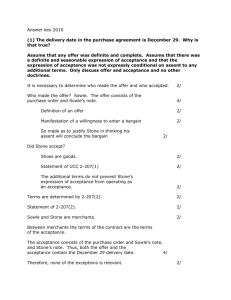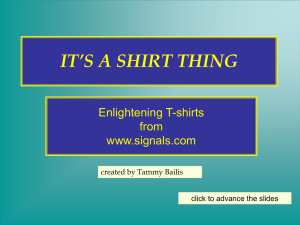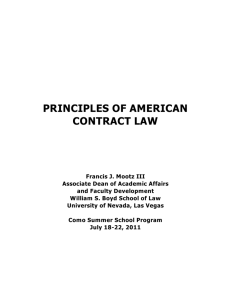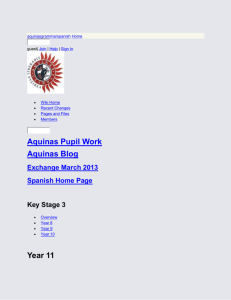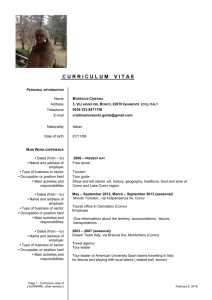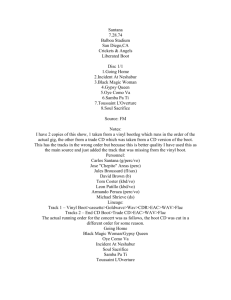Final
advertisement
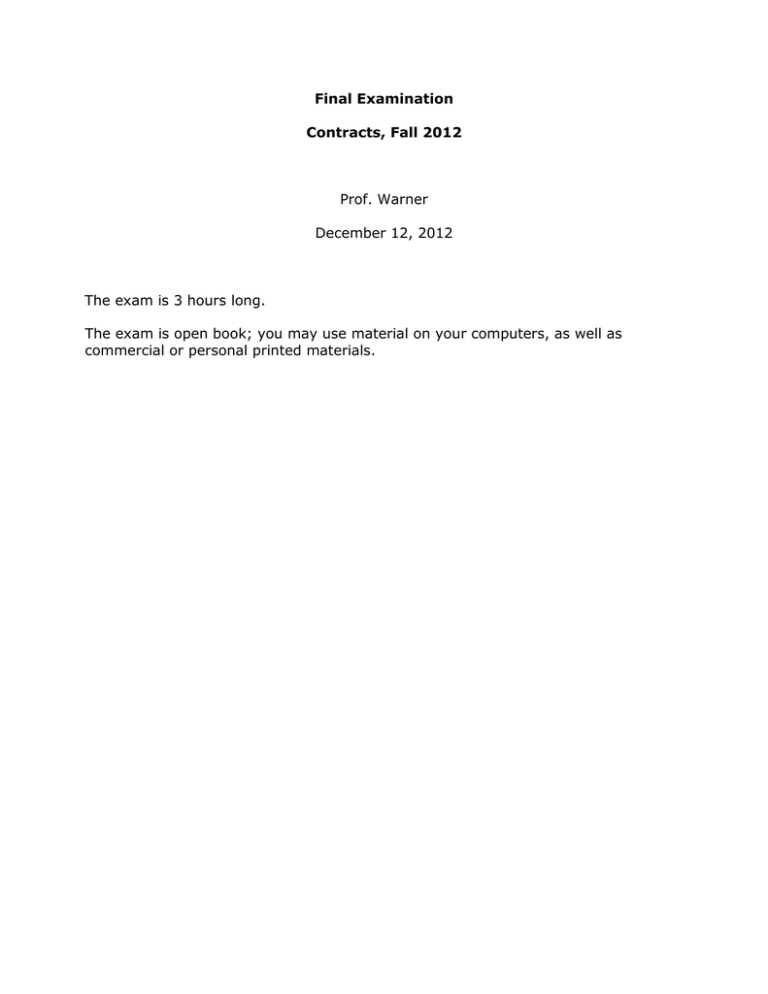
Final Examination Contracts, Fall 2012 Prof. Warner December 12, 2012 The exam is 3 hours long. The exam is open book; you may use material on your computers, as well as commercial or personal printed materials. Steve Sowle, a chess grandmaster, is negotiating with Santana Press about publishing his autobiography, Sowle Sacrifice. Sowle is also the President and CEO of Chess Press, the publisher of Play Chess with Sowle, a series of books about how to play chess. Sowle has transferred the copyright of Sowle Sacrifice to Chess Press and is negotiating with Santana Publishing on behalf of Chess Press. In the middle of the negotiations, Sowle meets with Carlos, who runs a marketing firm. Carlos explains that his firm, Oye Como Va, specializes in social media marketing and that he is confident that marketing in this way will increase the sales of Sowle Sacrifice. Carlos says, “Our marketing will get you double what you pay us,” and he produces data to back this up. Sowle is skeptical at first. He explains that he once ran a marketing company, and he tells Carlos, “I was one of the best. If you fail to perform, I will do the marketing myself. I still have the knack.” Finally, however, Sowle says, “Send me a proposal.” Carlos sends Sowle a letter explaining in detail the options Oye Como Va offers its clients. He includes an unsigned copy of the firms standard form agreement between Sowle and Oye Como Va says in the letter, “I numbered the various options we offer in the letter. Just circle the numbers of the options you want and attached the letter to the contract. Sign the agreement and return it to me. I am sure we have a deal, but I have to run it by my partner first. When he gives his OK, we will sign the agreement on behalf of Oye Como Va.” Sowle does just as Carlos asks. Carlos’s partner does give his OK, and, as representatives of Oye Como Va, they both sign and return the agreement (along with the letter with the circled options) to Sowle; they include a note that says, “We are delighted our deal is done in accord with the agreement and attached letter with circled options. We wanted to let you know that we have added a new service, described below. That service is included at the same price. Interested?” Sowle never responds to the note. In reliance on the agreement with Oye Como Va, Sowle spends $2,000 on an expert to develop his own LinkedIn and Facebook sites. Oye Como Va does not require this, but Sowle correctly believes that good looking sites of his own will supplement Oye Como Va’s efforts. A bit later, Santana Publishing sends Sowle its standard publishing contract in a letter that says, “Enclosed please find our signed contract for your consideration and acceptance.” It specifies all relevant details of the deal. Among other things, it contains these two clauses: Entire agreement clause: this agreement represents the complete and final statement of the parties obligations. Neither party is relying on any oral or written representations not contained in this agreement. Other royalties: On translations, licensing sales, electronic database sales, excerpts, abridgments, direct response sales, deep discount sales (sales at a discount of fifty percent or greater of the Publisher’s established list price of the Work), the Publisher shall pay royalties at one-half of the rate set forth in Paragraph 6(b) above in respect of the Publisher’s net receipts. In the event the Work is included in an electronic database with other works, or is otherwise exploited in combination with other works, royalties shall be apportioned by Publisher in its sole discretion, exercised in good faith.” Sowle is concerned that the “other royalties” provision may mean that Santana Publishing can license the entire work to Google Books and determine the royalty due Sowle at its discretion. He calls Santana Press to talk with its president, who says, “No problem. We will agree that if Santana Press licenses Sowle Sacrifice to Google Books, the press shall pay royalties at one-half of the rate set forth in Paragraph 6(b) above in respect of the Publisher’s net receipts.” Sowle says, “Good! It’s a deal then?” The president responds, “Deal. Put that in your acceptance if you want.” Later, just before he signs the publishing agreement, he calls the president of Santana Press and says, “We have talked about a lot of things in our negotiations. I want everything to be clear. I note the entire agreement clause, and I would like us both to acknowledge now that the written agreement really is the complete and final statement of our obligations.” The president responds, “So acknowledged.” When Sowle, as President of Chess Press, signs and returns the agreement, he includes a note that says in full, “I hereby accept your kind offer to publish Sowle Sacrifice. Should Santana Press license Sowle Sacrifice to Google Books, it shall pay royalties at one-half of the rate set forth in Paragraph 6(b) above in respect of the Publisher’s net receipts.” Santana Press responds in an email that says, “Just confirming we received your acceptance.” It does not mention the royalty provision Sowle added. Sowle Sacrifice is scheduled for publication in March 2013, and Sowle’s contract with Oye Como Va obligates it to begin marketing on social media sites on April 1, 2013. Oye Como Va uses Amazon’s cloud computing services to maintain all of its business operations and its entire Internet presence, and on March 31, Amazon’s entire cloud computing services go down for seven days, and Oye Como Va is unable to begin marketing until April 7. On April 3, a new autobiography, My Life: Art and Sacrifice, appears on the market by Sowle’s longtime rival, Mikhail Tal, and is immediately very popular, promoted in part by an intense marketing campaign on social media. It was common knowledge in the chess publishing world that Tal would publish his biography in the first four months of 2013, but it was uncertain what the exact date would be. It is well known in the chess publishing world is that, when rival books are published close together, the better marketed book sells better. On April 1, Sowle realized his marketing needs to match Tal’s, and he took over the social media marketing himself when Oye Como Va was unable to perform; his efforts were as effective as Oye Como Va’s would have been. Sowle’s time, effort, and expenses come to $2,000, which is approximately what Oye Como Va itself would have spent in that time period marketing Sowle Sacrifice had it been able to do so. After April 7, Oye Como Va performs as promised, and Sowle’s ceases his own marketing efforts. During the preparation of the manuscript, Santana Press discovers that Sowle has submitted the illustrations for the book in .jpg format. It points out to Sowle that the publishing contract requires him to submit illustrations in “an acceptable format as defined in the manual, Instructions To Authors.” Sowle did not read the manual, which was provided along with the contract prior to signing. It specifies that the only acceptable format is the .ai format (the Adobe Illustrator format). Sowle entered the contract thinking that “acceptable formats” included the .jpg format. Santana Press’s view of course was that only .ai was acceptable. Questions Where the parol evidence rule is relevant, use the rule as stated in class, and use only the normal inclusion test for scope. (1) Did Sowle and Oye Como Va (as represented by Carlos and his partner) satisfy the requirements of offer and acceptance in regard to Oye Como Va’s marketing services? (2) Do Santana Press’s obligations to Sowle include the following: if Santana Press licenses Sowle Sacrifice to Google Books, the press shall pay royalties at one-half of the rate set forth in Paragraph 6(b) above in respect of the Publisher’s net receipts? Identify and analyze two possible sources of this obligation. Use the UCC, and assume that Sowle’s conversation with the president satisfies the requirements of offer and acceptance and consideration. With regard to the written agreement, you do not need to discuss consideration. You may assume that any expression of acceptance is definite and seasonable. You may assume that the royalty provision Sowle includes is not a material alteration. (3) Oye Como Va claims that its written agreement with Sowle is unenforceable under parol evidence rule. Is it correct? (4) Oye Como Va claims that impracticability doctrine excused its obligation to market during the April 1 – 6 period. Is it correct? (5) What are Sowle’s expectation/mitigation damages from Oye Como Va’s failure to perform from April 1 to April 6? (6) Sowle claims he is not obligated to submit illustrations in .ai format. Is he correct? UCC Section § 2-207. Additional Terms in Acceptance or Confirmation. (1) A definite and seasonable expression of acceptance or a written confirmation which is sent within a reasonable time operates as an acceptance even though it states terms additional to or different from those offered or agreed upon, unless acceptance is expressly made conditional on assent to the additional or different terms. (2) The additional terms are to be construed as proposals for addition to the contract. Between merchants such terms become part of the contract unless: (a) the offer expressly limits acceptance to the terms of the offer; (b) they materially alter it; or (c) notification of objection to them has already been given or is given within a reasonable time after notice of them is received. (3) Conduct by both parties which recognizes the existence of a contract is sufficient to establish a contract for sale although the writings of the parties do not otherwise establish a contract. In such case the terms of the particular contract consist of those terms on which the writings of the parties agree, together with any supplementary terms incorporated under any other provisions of this Act. Restatement Section Restatement (Second) Contracts § 201 201. WHOSE MEANING PREVAILS (1) Where the parties have attached the same meaning to a promise or agreement or a term thereof, it is interpreted in accordance with that meaning. (2) Where the parties have attached different meanings to a promise or agreement or a term thereof, it is interpreted in accordance with the meaning attached by one of them if at the time the agreement was made (a) that party did not know of any different meaning attached by the other, and the other knew the meaning attached by the first party; or (b) that party had no reason to know of any different meaning attached by the other, and the other had reason to know the meaning attached by the first party. (3) Except as stated in this Section, neither party is bound by the meaning attached by the other, even though the result may be a failure of mutual assent.
